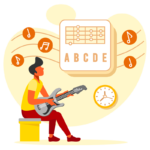

I had just fallen into the freezing water.
It was night.
I was holding my breath under the water.
I opened my eyes and I couldn’t see anything. Total darkness.
I pulled my head out of the water.
I couldn’t figure out a safe direction to reach the beach.
So, I started swimming slowly and carefully, without knowing if there are rocks or anything else around.
I didn’t know if at the next move I’ll hit something.
Outside my friends were waiting for me and the few other buddies who were with me in the water.
We started a small fire to get warm.
We played the guitar and a couple of hours later we returned to the hotel.
I haven’t swim night to unknown waters since then.
It was May 1st 1999.
![]()
![]()
A guitar fretboard is just like that.
It’s like the sea.
If you don’t have solid fretboard knowledge it’s like swimming in the dark.
There will always be the fear of the unexplored, of the unknown that could end up to wrong or non-sense notes.
Your friends (or fans) will be always waiting for you outside the water, around the fire (stage) to play some nice songs for them and have fun.
They don’t know how it is to swim (play) into the complete darkness.
You should figure out how to bring light into the dark, “mapping out” the fretboard.
There is a complete system of how to decode and unlock the fretboard.
By mastering that you’ll never swim into the darkness again.
Instead, you’d be able to play across the entire fretboard, express yourself, be creative and have fun like swimming safe into crystal clear waters!
For me, fretboard knowledge (along with music theory) is the foundation for building your unique sound, your own “voice”.
The audience is always thirsty for artists with original, signature sound.
The first step of unlocking the fretboard is the CAGED of 5 Pattern System.
I have a detailed article on how it works and how to practice it using a method that I call Fretboard Passepartout.